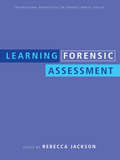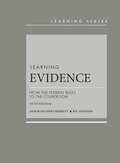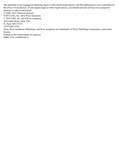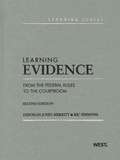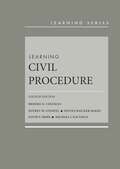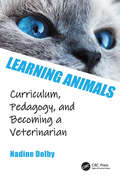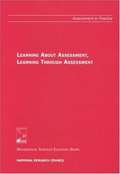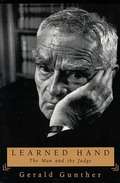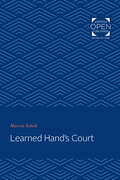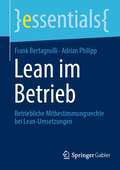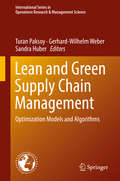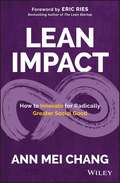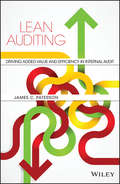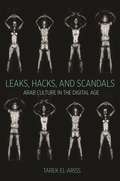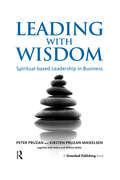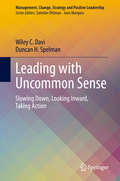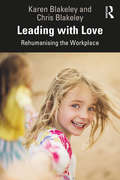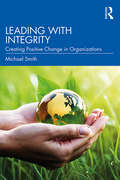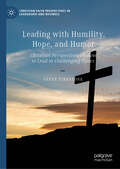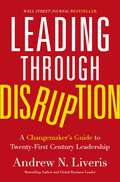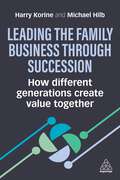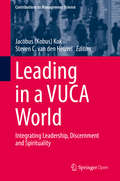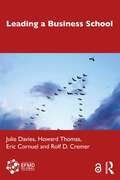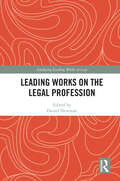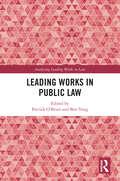- Table View
- List View
Learning Forensic Assessment
by Rebecca JacksonProviding an excellent resource for forensic psychology undergraduate students, this book offers students the opportunity to learn from experts, through the collection of outstanding articles. Unlike other books in the area that are topic specific, it also gives them comprehensive coverage of the subject. Divided into five broad topic areas, it covers: professional issues juvenile assessment criminal forensic assessment civil forensic assessment pervasive issues – malingering and psychopathy. Written by a group of internationally renowned contributors and including didactic information as well as providing discussions on practical issues regarding assessment and assessment instruments, this textbook will be invaluable reading for all students of forensic psychology.
Learning Evidence: From the Federal Rules to the Courtroom (Learning Series)
by Ric Simmons Deborah MerrittAs a part of our CasebookPlus offering, you'll receive a new print book along with lifetime digital access to the downloadable eBook. In addition, you'll receive 12-month online access to the Learning Library which includes quizzes tied specifically to your book, video lectures, “Evidence in Practice” interactive trial videos, an outline starter and three leading study aids in that subject and the Gilbert® Law Dictionary. The included study aids are Federal Rules of Evidence in a Nutshell, Acing Evidence and Exam Pro on Evidence, Objective. The redemption code will be shipped to you with the book. CHAR(13) + CHAR(10) CHAR(13) + CHAR(10)Learning Evidence engages students by offering lucid explanations of each evidentiary rule and colorful courtroom examples that explore how each rule works in practice. The fifth edition has been fully updated to reflect the continued emergence of electronic media, heightened attention to issues of race and gender, and recent amendments to the Federal Rules of Evidence. CHAR(13) + CHAR(10) CHAR(13) + CHAR(10)To deepen student learning, this edition comes with digital study aids, accessible at eproducts.westacademic.com. The study aids include hundreds of multiple choice, short answer, and essay questions; thirteen videos that review difficult subjects; and seven interactive simulations in which students take the role of a trial attorney or judge during a trial and then make or rule on objections in real time.
Learning Evidence: From the Federal Rules to the Courtroom
by Ric Simmons Deborah MerrittLearning Evidence engages students by offering colorful courtroom examples, excerpts from trial transcripts, and lucid explanations of each evidentiary rule. <p><p>The fourth edition has been fully updated to reflect the continued emergence of electronic media, the Supreme Court’s Sixth Amendment jurisprudence, and recent amendments to the Federal Rules of Evidence. To deepen student learning, the edition includes links to a dozen online videos, as well as interactive simulations in which students play the role of trial lawyers or judges.
Learning Evidence: From The Federal Rules To The Courtroom
by Deborah Jones Merritt Ric SimmonsLearning Evidence engages students by offering colorful courtroom examples, excerpts from trial transcripts, and lucid explanations of each evidentiary rule. The second edition has been fully updated to reflect the emergence of electronic media, the Supreme Court's Sixth Amendment jurisprudence, and the restyled Federal Rules of Evidence.
Learning Civil Procedure (Learning Series)
by Michael J. Kaufman Steven Baicker-McKee Brooke D. Coleman Jeffrey W. Stempel David F. HerrLearning Civil Procedure provides a broad, student-centered, user-friendly approach to civil procedure that is both clear and sophisticated. Students build mastery of the material through the presentation of examples and analyses. Students then move on to involved problems similar to what they will encounter on final examinations, bar examinations, and as lawyers. The book makes great use of problems to facilitate dialogue in class and correspondingly uses many fewer case excerpts than does the typical casebook. Students will emerge as competent and culturally literate lawyers because the book also includes the core "canon" of civil procedure opinions as well as sufficient historical background. <p><p>Learning Civil Procedure is a book designed by authors who both teach and litigate, making it the perfect tool for ensuring that students are ready for the classroom, the bar exam, and real-world litigation practice.
Learning Animals: Curriculum, Pedagogy and Becoming a Veterinarian
by Nadine DolbyWe are surrounded by thousands of animals, alive and dead. They are an intimate and ever-present part of our human lives. As a society, we privilege veterinarians as experts on these animals: they are our educators and teachers in what they say, what they do, and the decisions that they make. Yet, within the field of education, there is little research on the curriculum, pedagogy, and experiences of veterinary school and students. What do veterinarians learn in veterinary school? How do their experiences during those four years shape their perceptions of animals? How do the structures, curriculum, and pedagogy of veterinary college create and influence these experiences? Learning Animals opens up this conversation through an exploration of the complicated, fascinating and often painful stories of a cohort of veterinary students as they make their four-year journey from matriculation through graduation. The book examines how the experiences of veterinary students shape how humans relate to animals, from public policy and decision-making about the environment and animals slaughtered for food, to the most personal decisions about euthanizing companion animals. The first full-length, critical, qualitative study of the perspectives of our primary teachers about animals, this will be a thought-provoking read for those in the fields of both educational research and veterinary education.
Learning About Assessment, Learning Through Assessment
by Mark DriscollA report on Learning About Assessment, Learning Through Assessment
Learned Hand: The Man and the Judge
by Gerald GuntherA powerfully moving account of the life of one of the great judges of the twentieth century, whose work has left a profound mark on our legal, intellectual, and social landscape. The greatest judge never to be appointed to the Supreme Court, he is widely considered to be the peer of Justices Holmes, Brandeis, and Cardozo.
Learned Hand's Court
by Marvin SchickOriginally published in 1970. This is a study of one of the most highly respected tribunals in the history of the English-speaking world—the United States Court of Appeals for the Second Circuit. Situated in Manhattan, the Second Circuit Court, serving New York, Connecticut, and Vermont, is the most important commercial court in the country. But, like other inferior courts, it has never been studied in depth. Marvin Schick provides a comprehensive analysis. From 1941 to 1951, Learned Hand presided over the Second Circuit as chief judge, and the court bore his stamp. But on its bench sat other men of great competence, judges Thomas W. Swan, August N. Hand, and Harrie B. Chase, as well as Charles E. Clark and Jerome N. Frank, whose constant disagreement characterized much of the court's work. Schick studies the Second Circuit Court from several angles: historical, biographical, behavioral, and case analytical. He tells a history of the court from its origins in 1789. He provides biographical sketches of the six judges who sat during Learned Hand's tenure as chief judge. He analyzes the many decisions handed down by the court, including the precedent setters. He examines the court's decision-making process, especially its unique procedures such as the memorandum system, which requires from the judges "preliminary opinions" in the cases they hear. A novel feature of this book is the correlation of votes of the Second Circuit judges with subsequent decisions of the Supreme Court.Schick was aided in his study by having access to the private papers of Judge Clark. These thousands of memoranda and letters throw much light on the workings of the Second Circuit Court and reveal the bargaining that went on among the judges in difficult cases. The Clark papers make possible a clearer understanding of the incessant conflict between Clark and Frank and show how this unusual relationship gave vitality to the Second Circuit.
Lean im Betrieb: Betriebliche Mitbestimmungsrechte bei Lean-Umsetzungen (essentials)
by Frank Bertagnolli Adrian PhilippBei Lean-Umsetzungen benötigen Betriebe Rechtssicherheit. Dem Betriebsrat müssen Möglichkeiten und Grenzen bekannt sein. Da das Betriebsverfassungsgesetz den Rahmen setzt, Lean aber hierbei selten Einklang findet, unterstützt dieses Buch den praktischen Umgang bei Lean-Umsetzungen. Aufgezeigt werden typische Fallbeispiele und deren betriebsverfassungsrechtliche Einordnung. Dies soll allen Beteiligten Sicherheit geben. Lean ist für die Menschen einzusetzen, nicht gegen sie. Wenn Arbeitgeber und Arbeitnehmer Lean in einem ordnungsgemäßen Rahmen gemeinsam umsetzen, gewinnen alle, auch das Unternehmen selbst. Das Einsatzgebiet ist für diejenigen, welche in Lean-Projekten eingebunden sind. Besonders empfohlen sei es für Betriebsräte, Lean-Experten, Berater, Manager und Personaler.
Lean and Green Supply Chain Management: Optimization Models and Algorithms (International Series in Operations Research & Management Science #273)
by Gerhard-Wilhelm Weber Turan Paksoy Sandra HuberThis book presents the latest developments in optimization and optimal control models; exact, approximate and hybrid methods; and their applications in lean and green supply chains. It examines supply chain network design and modeling, closed loop supply chains, and lean, green, resilient and agile or responsive networks, and also discusses corporate social responsibility and occupational health and safety. It particularly focuses on supply chain management under uncertainty – employing stochastic or nonlinear modeling, simulation based studies and optimization – multi-criteria decision-making and applications of fuzzy set theory, and covers various aspects of supply chain management such as risk management, supplier selection or the design of automated warehouses. Lastly, using experimental applications and practical case studies, it shows the impact of lean and green applications on vehicle/fleet management and operations management.
Lean Impact: How To Innovate For Radically Greater Social Good
by Eric Ries Ann ChangDespite enormous investments of time and money, are we making a dent on the social and environmental challenges of our time? What if we could exponentially increase our impact? Around the world, a new generation is looking beyond greater profits, for meaningful purpose. But, unlike business, few social interventions have achieved significant impact at scale. Inspired by the modern innovation practices, popularized by bestseller The Lean Startup, that have fueled technology breakthroughs touching every aspect of our lives, Lean Impact turns our attention to a new goal - radically greater social good. Social change is far more complicated than building a new app. It requires more listening, more care, and more stakeholders. To make a lasting difference, solutions must be embraced by beneficiaries, address root causes, and include an engine that can accelerate growth to reach the scale of the need. Lean Impact offers bold ideas to reach audacious goals through customer insight, rapid experimentation and iteration, and a relentless pursuit of impact. Ann Mei Chang brings a unique perspective from across sectors, from her years as a tech executive in Silicon Valley to her most recent experience as the Chief Innovation Officer at USAID. She vividly illustrates the book with real stories from interviews with over 200 organizations across the US and around the world. Whether you are a nonprofit, social enterprise, triple bottom line company, foundation, government agency, philanthropist, impact investor, or simply donate your time and money, Lean Impact is an essential guide to maximizing social impact and scale.
Lean Auditing
by James C. Paterson"How can you argue with the core principles of Lean, that you focus on what provides value to your customer and eliminate work that is not necessary (muda)? Internal auditors need to understand not only who their primary customers are, but what is valuable to them - which in most cases is assurance that the risks that matter to the achievement of objectives are properly managed. We need to communicate what they need to know and not what we want to say. This incessant focus on the customer and the efficient production of a valued product should extend to every internal audit team. How else can we ensure that we optimize the use of our limited resources to address the dynamic business and risk environment within which our organizations operate?"Norman Marks, GRC Thought LeaderUsing lean techniques to enhance value add and reduce waste in internal auditingLean Auditing is a practical guide to maximising value and efficiency in internal audit through the application of lean techniques. It is an ideal book for anyone interested in understanding what progressive, value adding audit can be like. It is also ideal for anyone wondering whether audit activities can be streamlined or better co-ordinated with other activities.The book contains practical advise from the author's experience as CAE of AstraZeneca PLC; from his work as a consultant specializing in this field; as well as insights from leading CAEs in the UK, US and elsewhere. In addition, there are important insights from thought leaders such as Richard Chambers (IIA US) and Norman Marks (GRC thought leader) and Chris Baker (Technical Manager of the IIA UK).Increasing pressure on resources is driving a need for greater efficiency in all areas of business, and Internal Audit is no exception. Lean techniques can help streamline the workflow, but having only recently been applied to IA, lack the guidance available for other techniques. Lean Auditing fills this need by combining expert instruction and actionable advice that helps Internal Auditors:Benchmark their efficiency against lean ways of workingUnderstand warning signs of waste and lower added valueUnderstanding practical ways of working that improve added value and reduce wasteGain confidence about progressive ways of working in internal auditUnderstand how improved ways of working in audit can positively impact the culture of the wider organizationOne of the keys to the lean audit is finding out exactly what the stakeholder wants, and eliminating everything else. Scaling back certain operations can delineate audit from advisory, and in the process, dramatically improve crucial outcomes. To this end, Lean Auditing is the key to IA efficiency.
Leaks, Hacks, and Scandals: Arab Culture in the Digital Age (Translation/transnation Ser. #40)
by Tarek El-ArissHow digital media are transforming Arab culture, literature, and politicsIn recent years, Arab activists have confronted authoritarian regimes both on the street and online, leaking videos and exposing atrocities, and demanding political rights. Tarek El-Ariss situates these critiques of power within a pervasive culture of scandal and leaks and shows how cultural production and political change in the contemporary Arab world are enabled by digital technology yet emerge from traditional cultural models.Focusing on a new generation of activists and authors from Egypt and the Arabian Peninsula, El-Ariss connects WikiLeaks to The Arabian Nights, Twitter to mystical revelation, cyberattacks to pre-Islamic tribal raids, and digital activism to the affective scene-making of Arab popular culture. He shifts the epistemological and historical frameworks from the postcolonial condition to the digital condition and shows how new media challenge the novel as the traditional vehicle for political consciousness and intellectual debate.Theorizing the rise of “the leaking subject” who reveals, contests, and writes through chaotic yet highly political means, El-Ariss investigates the digital consciousness, virality, and affective forms of knowledge that jolt and inform the public and that draw readers in to the unfolding fiction of scandal.Leaks, Hacks, and Scandals maps the changing landscape of Arab modernity, or Nahda, in the digital age and traces how concepts such as the nation, community, power, the intellectual, the author, and the novel are hacked and recoded through new modes of confrontation, circulation, and dissent.
Leading with Wisdom: Spiritual-based Leadership in Business
by William Miller Peter Pruzan Kirsten Pruzan-Mikkelsen Debra MillerThis ground-breaking book portrays an emerging global culture. It offers the experiences and perspectives of 31 top executives from 15 countries in 6 continents. These are business people who express from first-hand experience what it is like to lead a business from a spiritual basis.
Leading with Uncommon Sense: Slowing Down, Looking Inward, Taking Action (Management, Change, Strategy and Positive Leadership)
by Wiley C. Davi Duncan H. SpelmanThis book offers alternatives to typical leadership, highlighting new ways of thinking about how individuals can lead effectively. Specifically, it integrates several fields, including neuroscience, behavioral economics, mindfulness, cognitive and social psychology, emotional intelligence, and management decision-making. The authors challenge the “common sense,” mainstream thinking about leadership, arguing that effective leadership depends on a more complicated understanding of the underlying dynamics.When leaders rely on the common sense that they have been taught explicitly or implicitly about leadership, the results are often not effective—for themselves personally, for their followers, for the organizations in which they lead, and for society as a whole. For example, aspiring leaders often believe that the mark of good leaders is their ability to come up with quick answers to problems. Others believe that one’s ability to minimize complexity and uncertainty indicates leadership potential. In addition, despite the literature suggesting the value of engaging in self-reflection, few leaders regularly step back and look inward. Even those who can intellectually discuss emotional intelligence often focus on their ability to influence the emotions of others rather than reflecting on and learning from their own emotions.The book calls for leaders to operate with more humility and greater awareness of the multiple contexts in which they function—approaches that improve life for all organizational members. As leaders become more effective, they will become healthier and more satisfied, less harried, more grounded, and more fulfilled in their lives.
Leading with Love: Rehumanising the Workplace
by Karen Blakeley Chris BlakeleyAs business becomes more automated, power more concentrated, and the forces of competition and consumption seem to dominate our lives, we are in danger of losing what it is to be human. Work for many can be a soulless activity, creating feelings of disempowerment, alienation, and depression. Learning to lead with love is a counterforce to the instrumentalisation of the person. This book presents original research based on leaders who were nominated by their people for leading with love. It shows how they learned to lead with love for the benefit of themselves, their organisations, and their people. It shows that leading with love is something that is practised by leaders who are more emotionally, morally, and spiritually mature. Leading with love is a sign of psychological maturity, whilst leading with fear is a sign of hindered emotional and spiritual development. Based on this research, this book presents a simple framework to help leaders who wish to develop their psychological maturity and apply practices which will enable them to successfully lead with love.
Leading with Integrity: Creating Positive Change in Organizations
by Michael SmithThanks to global news and social media, we are the most informed and socially conscious generation in history. But what are the sources of inner inspiration that guide our daily conduct and motivations in the workplace? Far from the old Machiavellian dictum that "the ends justify the means", the reverse is often the case: the means determine the ends. This book presents the stories of business leaders who have aimed to build trust in the economy, and have delivered value through integrity, cooperation, stewardship, purpose and sustainability. It proposes the eight Cs of trust which can define the culture of organizations: contracts, covenants, competences, character, conscience, conviction, courage and change. The book makes the clear link between personal decision-making and global outcomes and demonstrates how positive decision-making can lead to change inside organizations and beyond.
Leading with Humility, Hope, and Humor: Christian Perspectives on How to Lead in Challenging Times (Christian Faith Perspectives in Leadership and Business)
by Steve FirestoneThis book explores the intricate interplay between humility, humor, and hope in the context of Christian leadership. Drawing upon biblical foundations and contemporary leadership theories, it provides a comprehensive understanding of how these three qualities synergize to enhance the effectiveness of Christian leaders. By examining their individual significance and exploring their combined impact, this volume advances the field of organizational leadership, particularly in addressing the challenges of leadership in a manner consistent with Christian principles. The authors illuminate the crucial roles of humility, hope, and humor in Christian leadership, making this a valuable resource for researchers interested in leadership within the context of faith. This contribution will aligns with existing literature on how Christians can leverage their faith for improved leadership capabilities.
Leading through Disruption: A Changemaker’s Guide to Twenty-First Century Leadership
by Andrew Liveris&“Andrew Liveris takes us on a masterclass in collaborative, forward-looking leadership."- Richard Branson, Founder, The Virgin GroupIn Leading Through Disruption, Andrew Liveris provides a new leadership paradigm for resilience and agility in a rapidly changing world. This book is a must-read guide for leaders in various sectors who are keen on not only ensuring current success, but protecting the planet&’s future for everyone. Liveris, who was recently chosen to lead the Brisbane 2032 Olympic Organizing Committee and is former Chairman and CEO of The Dow Chemical Company, presents a variety of powerful tools that will enable you to tackle any problem quickly and responsively, with an eye to creating a more equitable, sustainable future. In these pages, you will learn how to:Create and use metrics that quantify the positive impact on all members of society.Collaborate with scientists, politicians, regulators, corporate boards, and other stakeholders to create effective policies that work.Broaden your company&’s focus to include both long-term sustainability and short-term profitability without sacrificing the former to gain the latter.Strengthen local communities via corporate investment and advocacy for the improvement of amenities and services for all.Hire team members who fully and proactively support strategies to improve the world and its future.Become a sought-after advisor on how to respond quickly and decisively to uncertainties. Andrew Liveris shares essential wisdom from his four decades of global leadership experience in business, government, academia, and civic society. His book is a powerful tool for any aspiring leader.
Leading the Family Business Through Succession: How Different Generations Create Value Together
by Professor Dr Michael Hilb Professor Harry KorineLeading the Family Business Through Succession examines leadership and succession in family business, showing how current and next generation members can develop the business side by side.It challenges the traditional, hierarchical model of leadership and succession in family business, showing that this approach is no longer aligned to modern organizational needs. Instead, this book examines how current and next generations can bridge the gap and co-evolve as peers for a significant stretch of time. It outlines leadership practices families can employ to navigate the transition towards new ways of working together and how generations can collaborate to address the myriad challenges and opportunities affecting businesses today, balancing legacy and transformation. This book is informed by methodologies tried-and-tested in years of MBA and executive-level teaching at business schools such as INSEAD, St Gallen and London Business School. Taking a global approach and drawing on cutting edge insights and research, it provides case studies and examples featuring family businesses from around the world, such as Europe, the Americas, the Far East and the Middle East, highlighting how different family businesses can learn from each other. It is ideal for MBA and executive level courses on family business and will also be of interest to family business leaders, advisors and managers.
Leading in a VUCA World: Integrating Leadership, Discernment and Spirituality (Contributions to Management Science)
by Jacobus Kobus Kok Steven C. van den HeuvelThis open access book brings together works by specialists from different disciplines and continents to reflect on the nexus between leadership, spirituality and discernment, particularly with regard to a world that is increasingly volatile, uncertain, complex, and ambiguous (VUCA). The book spells out, first of all, what our VUCA world entails, and how it affects businesses, organizations, and societies as a whole. Secondly, the book develops new perspectives on the processes of leadership, spirituality, and discernment, particularly in this VUCA context. These perspectives are interdisciplinary in nature, and are informed by e.g. management studies, leadership theory, philosophy, and theology.
Leading a Business School
by Howard Thomas Julie Davies Eric Cornuel Rolf D. CremerBusiness schools are critical players in higher education, educating current and future leaders to make a difference in the world. Yet we know surprisingly little about the leaders of business schools. Leading a Business School demystifies this complex and dynamic role, offering international insights into deans’ dilemmas in different contexts and situations. It highlights the importance of deans creating challenging and supportive learning cultures to enhance business and management education, organizations and society more broadly. Written by renowned experts on the role of the dean, Julie Davies, Howard Thomas, Eric Cornuel and Rolf D. Cremer, the book traces the historical evolution of the business school deanship, the current challenges and future sources of disruption. The leadership characteristics and styles of business school deans are presented based on an examination of different dimensions of their roles. These include issues of strategic positioning, such as financial viability, prestige, size, mission, age, location and programme portfolios, as well as the influences of rankings, sector accreditations, governance structures, networks and national policies on strategy implementation. Drawing on international case studies and deans’ development programmes globally, the authors explore constraints on deans’ autonomy, university and external relations, and how business school deans add value over the period of their tenures. This candid and well-researched book is essential reading for aspiring business school leaders, those hiring and working with deans, and other higher education leaders. The Open Access version of this book, available at http://www.taylorfrancis.com, has been made available under a Creative Commons Attribution-Non Commercial-No Derivatives (CC-BY-NC-ND) 4.0 license. Funded by EFMD Global.
Leading Works on the Legal Profession (Analysing Leading Works in Law)
by Daniel NewmanThis collection provides an innovative and engaging way of assessing the development of legal profession scholarship and its potential future development by presenting an analysis of the ‘leading works’ of the discipline. The book was written by prominent and emerging international scholars in the field, with each contributor having been invited to select and analyse a work which has for them shed light on what the legal profession is and what it does. The chapters explore the effect that the chosen work has had upon legal profession scholarship as a whole, both within particular jurisdictions and internationally. Contributors also reflect upon the likely implications of the leading work on the future study of and application to the legal profession. They relate the works to recent and contemporary developments in law and access to justice, such as the rise of technology, impact of the Covid-19 pandemic, and issues of funding, to highlight the interpretative value of such scholarship. Presenting an overview and introduction to the field of legal profession research, the collection will be required reading for researchers looking to study any aspect of the legal profession. It will also prove compelling for a wide variety of access to justice and justice system research projects. The book will also appeal to scholars interested in legal ethics.
Leading Works in Public Law (Analysing Leading Works in Law)
by Patrick O’Brien and Ben YongThis book brings together a group of leading scholars working in public law and constitutional theory. It examines accepted leading works of public law while also exploring those that deserve greater attention. Over 13 chapters, a group of leading public law experts each examine one leading work from the UK public law canon. Each chapter critically reflects on the context of a work in public law, taking into account not just the work and its context but also how it shapes and contributes to the broader discipline. The final chapter offers an international overview of the chapters themselves, reflecting critically on the scholarly canon of UK public law from the perspective of American constitutional scholarship. The book will be of interest to scholars and students of constitutional law.
